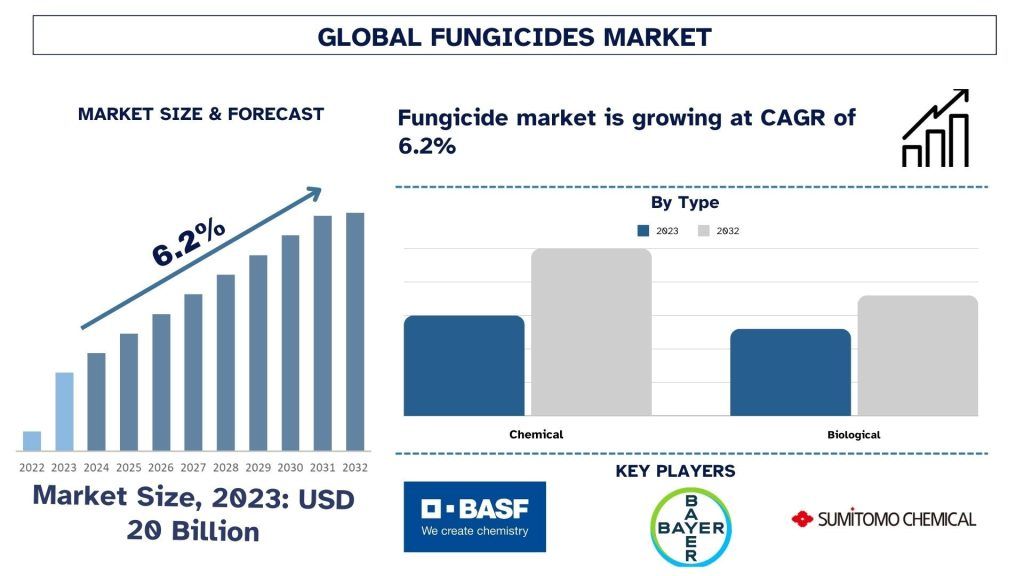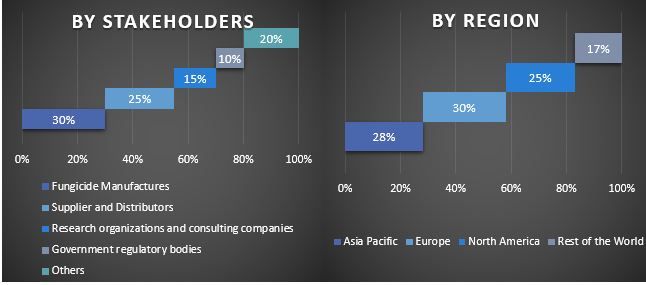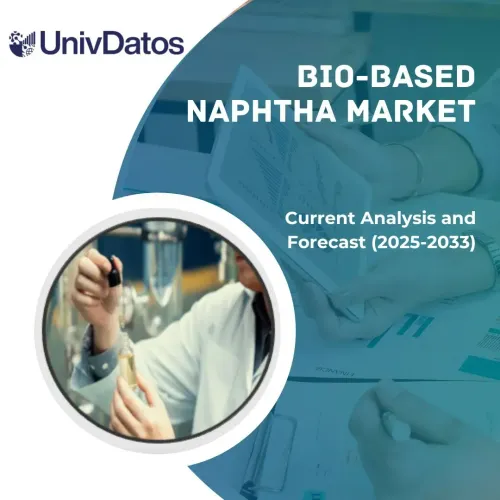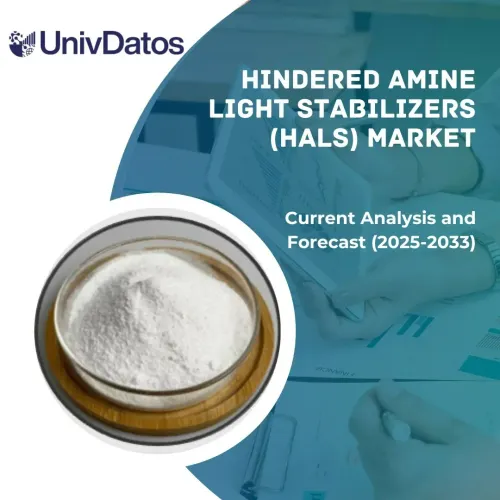- Home
- Chi siamo
- Settore
- Servizi
- Lettura
- Contattaci
Tržište fungicida: Trenutna analiza i prognoza (2024.-2032.)
Naglasak na vrstu (kemijska i biološka); usjev (žitarice i sjemenke, uljarice i mahunarke, voće i povrće i ostalo); primjenu (tretiranje sjemena, tretiranje tla, folijarno prskanje, nakon berbe i ostalo); regiju i državu
Veličina i prognoza tržišta fungicida
Vrijednost tržišta fungicida procijenjena je na približno 20 milijardi USD u 2023., a očekuje se da će rasti po snažnoj složenoj godišnjoj stopi rasta od oko 6,2% tijekom predviđenog razdoblja (2024.-2032.). Tržište fungicida se širi zbog nekoliko razloga, kao što su potrebe za hranom rastućeg stanovništva na globalnoj razini u kombinaciji s poboljšanjima u poljoprivrednim praksama i zabrinutosti zbog gubitaka usjeva zbog gljivičnih bolesti.
Analiza tržišta fungicida
Tijekom godina, svijet je svjedočio porastu broja stanovnika i kontinuirano raste kako bi se stvorila veća potražnja za hranom i promjene u obrascima potrošnje hrane. I pritisak na zemljište, koje je ograničen resurs, također je porastao. Međutim, rast broja stanovnika nadmašio je rast zemljišta, čime se smanjilo poljoprivredno zemljište po stanovniku. Osim toga, bolesti koje oštećuju usjeve i biljke također se povećavaju. One smanjuju proizvodnju usjeva i postoji ogroman ekonomski gubitak. Na primjer, Organizacija za hranu i poljoprivredu (FAO) procjenjuje da se godišnje do 40 posto globalne proizvodnje usjeva izgubi zbog štetočina. Svake godine bolesti biljaka globalnu ekonomiju koštaju preko 220 milijardi dolara, a invazivni insekti najmanje 70 milijardi dolara. Ovo smanjenje proizvodnje usjeva zbog bolesti i rastuća populacija povećali su globalni fokus na poboljšanje prinosa usjeva, čime se povećava interes proizvođača fungicida za proizvodnju naprednijih, produktivnijih i manje toksičnih za ljude, fungicida. Fungicidi su proizvodi koji se koriste za zaštitu poljoprivrednih proizvoda od insekata, štetočina i bolesti. To su specifični proizvodi koji se također koriste za poboljšanje kvalitete i povećanje proizvodnje usjeva.
Trendovi na tržištu fungicida
Ovaj odjeljak raspravlja o ključnim tržišnim trendovima koji utječu na segmente fungicida kako su ih identificirali naši istraživački stručnjaci.
Biološki segment transformira industriju
Na temelju vrste, tržište je kategorizirano na kemijsko i biološko. Od oba, biološka kategorija će vjerojatno pokazati snažan rast tijekom predviđenog razdoblja zbog sve veće primjene s obzirom na promjenu fokusa na organske proizvode. Biološki fungicidi sastoje se od organske tvari koja se koristi u poljoprivrednom sektoru za suzbijanje patogenih organizama, zaraze insektima i biljnih bolesti. Bio-fungicid također igra vitalnu ulogu u poboljšanju kvalitete tla obradivih površina uravnoteženjem esencijalnih sadržaja tla. Štoviše, kemijski fungicidi ponekad ubijaju usjeve i biljke ako se s njima ne rukuje pažljivo jer sadrže otrovne tvari.
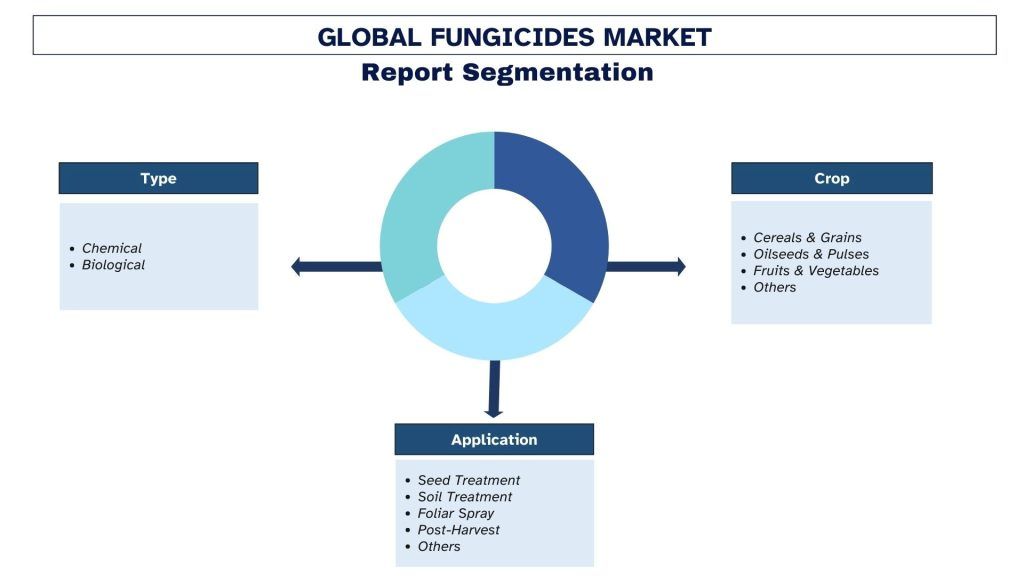
Azija i Pacifik će držati značajan udio na tržištu
Velika baza poljoprivrednog sektora azijsko-pacifičke regije pomogla je regiji da stekne dominantan položaj na tržištu. Regionalna potražnja za fungicidima zbog poljoprivredne potrošnje potrebna je za prehranu rastućeg i većeg broja stanovnika. Uz to, u zemljama poput Indije i drugih zemalja jugoistočne Azije, obradivo zemljište po osobi smanjuje se alarmantnom brzinom kako se stanovništvo povećava, a zbog zagađenja i klimatskih uvjeta bolesti se također povećavaju, ovdje upotreba fungicida može igrati važnu ulogu u povećanju prosječnih prinosa usjeva po hektaru.
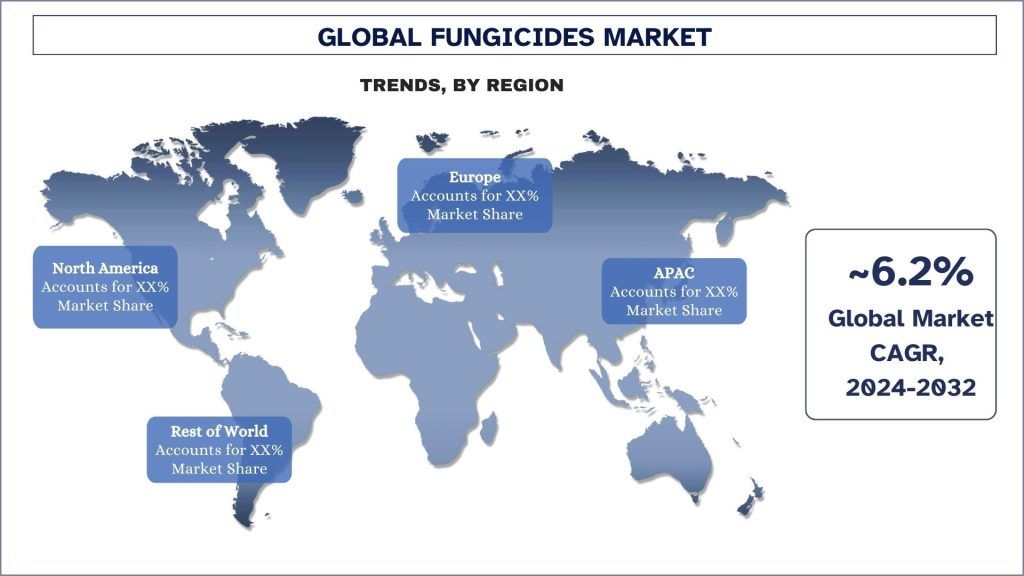
Pregled industrije fungicida
Fungicidi su konkurentni, s nekoliko globalnih i međunarodnih tržišnih igrača. Ključni igrači usvajaju različite strategije rasta kako bi poboljšali svoju prisutnost na tržištu, kao što su partnerstva, sporazumi, suradnje, lansiranja novih proizvoda, geografska proširenja i spajanja i akvizicije. Neki od glavnih igrača koji djeluju na tržištu su BASF, Bayer AG, Sumitomo Chemical Co. Ltd., Syngenta AG, Corteva, UPL, ADAMA, JIANGSU YANGNONG CHEMICAL CO., LTD, Nufarm Canada, FMC Corporation. Nekoliko spajanja i akvizicija, zajedno s partnerstvima, poduzeli su ovi igrači kako bi kupcima olakšali visokotehnološke i inovativne proizvode/tehnologije.
Nedavni razvoj
U 2024. Syngenta India predstavila je Miravis Duo i Reflect Top, dva inovativna fungicida. Miravis Duo rješava gljivične bolesti u rajčicama, čiliju, kikirikiju i grožđu, dok Reflect Top pruža učinkovitu zaštitu od truleži stabljike za rižu. Ovi su proizvodi osmišljeni za povećanje prinosa usjeva i podršku vitalnom poljoprivrednom sektoru Indije, posebno u izvozu.
Izvješće o tržištu fungicida - pokrivenost
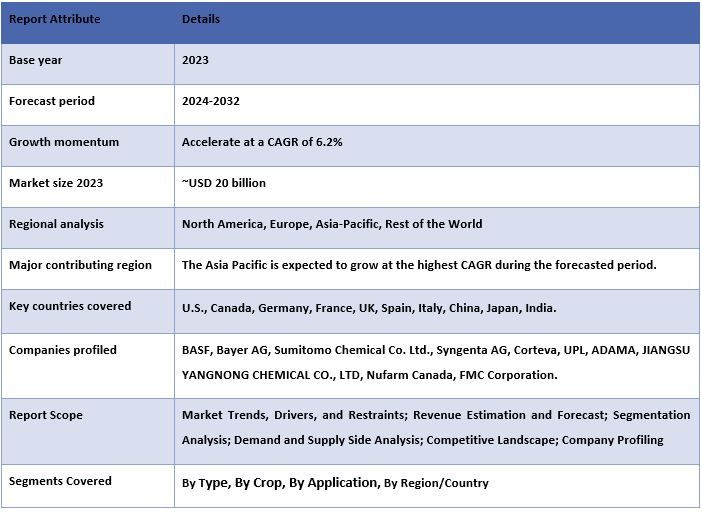
Razlozi za kupnju ovog izvješća:
- Studija uključuje analizu veličine i prognoze tržišta koju su potvrdili ovlašteni ključni stručnjaci iz industrije.
- Izvješće predstavlja brzi pregled cjelokupne uspješnosti industrije na prvi pogled.
- Izvješće pokriva detaljnu analizu istaknutih kolega iz industrije s primarnim fokusom na ključne poslovne financije, portfelje proizvoda, strategije širenja i nedavna događanja.
- Detaljan pregled pokretača, ograničenja, ključnih trendova i mogućnosti koje prevladavaju u industriji.
- Studija sveobuhvatno pokriva tržište u različitim segmentima.
- Detaljna regionalna analiza industrije.
Mogućnosti prilagodbe:
Globalni fungicidi mogu se dodatno prilagoditi prema zahtjevu ili bilo kojem drugom tržišnom segmentu. Osim toga, UMI razumije da možda imate vlastite poslovne potrebe; stoga se slobodno povežite s nama kako biste dobili izvješće koje u potpunosti odgovara vašim zahtjevima.
Indice
Metodologija istraživanja za analizu tržišta fungicida (2022.-2032.)
Analiza povijesnog tržišta, procjena trenutnog tržišta i predviđanje budućeg tržišta globalnog tržišta fungicida bila su tri glavna koraka poduzeta za stvaranje i analizu primjene fungicida u glavnim regijama na globalnoj razini. Opsežno sekundarno istraživanje provedeno je za prikupljanje povijesnih brojki tržišta i procjenu trenutne veličine tržišta. Drugo, brojne spoznaje i pretpostavke uzete su u obzir za validaciju tih spoznaja. Štoviše, opsežni primarni intervjui također su provedeni sa stručnjacima iz industrije duž vrijednosnog lanca globalnog tržišta fungicida. Nakon pretpostavke i validacije brojki tržišta putem primarnih intervjua, primijenili smo pristup od vrha prema dolje/odozdo prema gore za predviđanje cjelokupne veličine tržišta. Nakon toga, usvojene su metode raščlanjivanja tržišta i triangulacije podataka za procjenu i analizu veličine tržišta segmenata i podsegmenata industrije. Detaljna metodologija objašnjena je u nastavku:
Analiza povijesne veličine tržišta
Korak 1: Detaljna studija sekundarnih izvora:
Provedena je detaljna sekundarna studija kako bi se dobila povijesna veličina tržišta fungicida putem internih izvora tvrtke, kao što su godišnja izvješća i financijski izvještaji, prezentacije učinka, priopćenja za tisak itd., i vanjskih izvora, uključujući časopise, vijesti i članke, vladine publikacije, publikacije konkurenata, sektorska izvješća, baze podataka trećih strana i druge vjerodostojne publikacije.
Korak 2: Segmentacija tržišta:
Nakon dobivanja povijesne veličine tržišta fungicida, proveli smo detaljnu sekundarnu analizu kako bismo prikupili povijesne spoznaje o tržištu i udjele za različite segmente i podsegmente za glavne regije. Glavni segmenti uključeni su u izvješće, kao što su vrsta, usjev, primjena i regija. Nadalje, provedene su analize na razini države kako bi se procijenila ukupna primjena modela testiranja u toj regiji.
Korak 3: Analiza faktora:
Nakon stjecanja povijesne veličine tržišta različitih segmenata i podsegmenata, proveli smo detaljnuanalizu faktorakako bismo procijenili trenutnu veličinu tržišta fungicida. Nadalje, proveli smo analizu faktora koristeći zavisne i nezavisne varijable kao što su vrsta, usjev, primjena i regija. Provedena je temeljita analiza scenarija ponude i potražnje uzimajući u obzir vrhunska partnerstva, spajanja i akvizicije, širenje poslovanja i lansiranje proizvoda u sektoru tržišta fungicida diljem svijeta.
Procjena trenutne veličine tržišta i prognoza
Procjena trenutne veličine tržišta:Na temelju djelotvornih spoznaja iz gore navedena tri koraka, došli smo do trenutne veličine tržišta, ključnih igrača na globalnom tržištu fungicida i tržišnih udjela segmenata. Svi potrebni postotni udjeli i raščlambe tržišta određeni su korištenjem gore spomenutog sekundarnog pristupa i provjereni su putem primarnih intervjua.
Procjena i prognoziranje:Za procjenu i prognoziranje tržišta, dodijeljene su težine različitim faktorima, uključujući pokretače i trendove, ograničenja i mogućnosti dostupne dionicima. Nakon analize tih čimbenika, primijenjene su relevantne tehnike predviđanja, tj. pristup od vrha prema dolje/odozdo prema gore, kako bi se došlo do tržišne prognoze za 2032. za različite segmente i podsegmente na glavnim tržištima globalno. Metodologija istraživanja usvojena za procjenu veličine tržišta obuhvaća:
- Veličinu tržišta industrije, u smislu prihoda (USD) i stopu primjene fungicida na glavnim tržištima u zemlji
- Svi postotni udjeli, raščlambe i raspodjele tržišnih segmenata i podsegmenata
- Ključni igrači na globalnom tržištu fungicida u smislu ponuđenih proizvoda. Također, strategije rasta koje su usvojili ti igrači za natjecanje na tržištu koje brzo raste
Validacija veličine tržišta i udjela
Ricerca primaria:Sono stati condotti colloqui approfonditi con i Key Opinion Leader (KOL), inclusi i Top Level Executives (CXO/VP, Sales Head, Marketing Head, Operational Head, Regional Head, Country Head, ecc.) in tutte le principali regioni. I risultati della ricerca primaria sono stati quindi riassunti e sono state eseguite analisi statistiche per dimostrare l'ipotesi dichiarata. Gli input dalla ricerca primaria sono stati consolidati con i risultati secondari, trasformando così le informazioni in approfondimenti fruibili.
Suddivisione dei partecipanti primari nelle diverse regioni
Ingegneria del mercato
La tecnica di triangolazione dei dati è stata impiegata per completare la stima complessiva del mercato e per arrivare a numeri statistici precisi per ogni segmento e sotto-segmento dei Fungicidi globali. I dati sono stati suddivisi in diversi segmenti e sotto-segmenti dopo aver studiato vari parametri e tendenze nel tipo, coltura, applicazione e regioni del mercato globale dei Fungicidi.
L'obiettivo principale dello Studio sul mercato globale dei Fungicidi
Le attuali e future tendenze del mercato dei Fungicidi globali sono state individuate nello studio. Gli investitori possono ottenere approfondimenti strategici per basare la propria discrezionalità sugli investimenti sull'analisi qualitativa e quantitativa eseguita nello studio. Le attuali e future tendenze del mercato hanno determinato l'attrattiva complessiva del mercato a livello regionale, fornendo una piattaforma per il partecipante industriale per sfruttare il mercato inesplorato per beneficiare di un vantaggio da pioniere. Altri obiettivi quantitativi degli studi includono:
- Analizzare le dimensioni attuali e previste del mercato dei Fungicidi in termini di valore (USD). Inoltre, analizzare le dimensioni attuali e previste del mercato dei diversi segmenti e sotto-segmenti.
- I segmenti nello studio includono aree di tipo, coltura, applicazione e regioni.
- Definire e analizzare il quadro normativo per i Fungicidi
- Analizzare la catena del valore coinvolta con la presenza di vari intermediari, insieme all'analisi dei comportamenti dei clienti e dei concorrenti del settore.
- Analizzare le dimensioni attuali e previste del mercato dei Fungicidi per le principali regioni.
- I principali paesi delle regioni studiate nel rapporto includono Asia Pacifico, Europa, Nord America e Resto del mondo
- Profili aziendali del mercato dei Fungicidi e le strategie di crescita adottate dagli attori del mercato per sostenersi nel mercato in rapida crescita.
- Analisi approfondita del settore a livello regionale.
Domande frequenti FAQ
Q1: Qual è l'attuale dimensione globale e il potenziale di crescita dei fungicidi?
Q2: Quali sono i fattori trainanti per la crescita del mercato globale dei fungicidi?
Q3: Quale segmento detiene la quota maggiore del mercato globale dei fungicidi per tipologia?
Q4: Quali sono le tecnologie e le tendenze emergenti nel mercato globale dei fungicidi?
Q5: Quale regione dominerà il mercato globale dei fungicidi?
Correlati Report
I clienti che hanno acquistato questo articolo hanno acquistato anche

